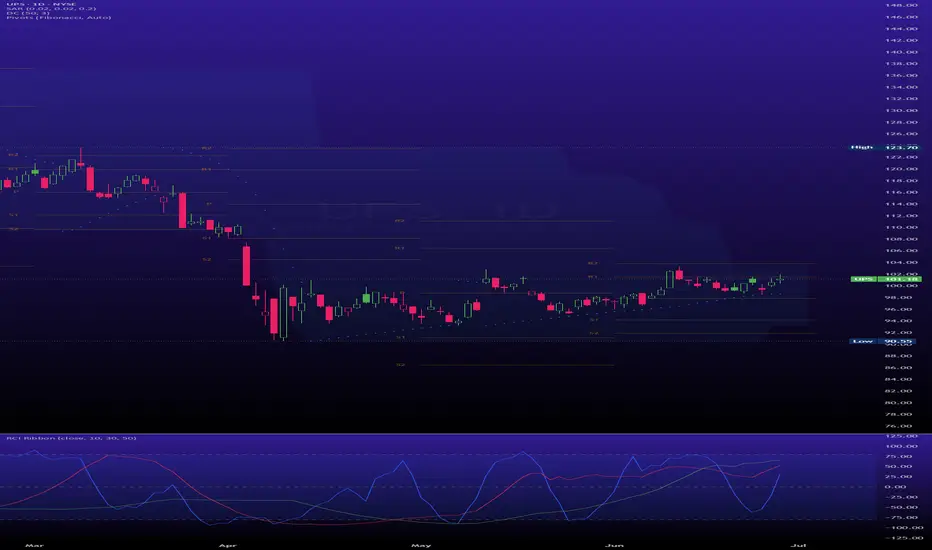### **Wyckoff Phase: Accumulation**
1. **Prior Downtrend:** The weekly chart (left) clearly shows a prolonged and significant downtrend through 2024 and into early 2025. This fulfills the "Markdown" phase that precedes accumulation.
2. **Stopping Action and Base Formation:** The daily chart (right) shows that the steep decline halted around March-April 2025. The price then rallied automatically and has since been consolidating sideways. This sideways trading range, following a major downtrend, is the hallmark of the Accumulation phase, where "smart money" may be absorbing shares and building a cause for a future rally.
3. **Confirming Indicators:** The "Neutral" rating from the technicals gauge confirms the current lack of a strong trend. Furthermore, the positive performance in the last week (+1.45%) and month (+3.62%) shows that selling pressure has subsided and short-term demand is emerging, which is consistent with the early stages of accumulation.
### **Suggested Option Strategy: Poor Man's Covered Call (PMCC)**
Given the analysis that UPS is building a base in an Accumulation phase (implying a neutral to bullish long-term outlook), a **Poor Man's Covered Call (PMCC)**, also known as a long call diagonal debit spread, is a suitable strategy.
This strategy allows you to establish a bullish position with less capital than buying 100 shares, while potentially generating income during the expected consolidation period.
**How it Works:**
This is an advanced strategy and should be approached with a full understanding of the risks.
1. **Buy a Long-Term, In-the-Money (ITM) Call:** Instead of buying 100 shares of UPS, you buy a single call option with a long time until expiration (e.g., 6-12 months). Choosing an in-the-money strike (a strike price below the current stock price) makes the option behave more like the stock.
2. **Sell a Short-Term, Out-of-the-Money (OTM) Call:** Against your long call, you sell a call option with a near-term expiration (e.g., 30-45 days) and a strike price that is above the current stock price.
**Goal of the Strategy:**
The objective is for the short-term call you sold to decrease in value faster than your long-term call due to time decay (theta). Ideally, the short call expires worthless, and you keep the premium. You can then repeat the process by selling another short-term call, continuously reducing the net cost of your long-term bullish position while you wait for the stock to potentially begin its "Markup" or uptrend phase.
***
*Disclaimer: This information is for educational purposes only and is not financial advice. Options trading involves significant risk and is not suitable for all investors. You should consult with a qualified financial professional before making any investment decisions.*
1. **Prior Downtrend:** The weekly chart (left) clearly shows a prolonged and significant downtrend through 2024 and into early 2025. This fulfills the "Markdown" phase that precedes accumulation.
2. **Stopping Action and Base Formation:** The daily chart (right) shows that the steep decline halted around March-April 2025. The price then rallied automatically and has since been consolidating sideways. This sideways trading range, following a major downtrend, is the hallmark of the Accumulation phase, where "smart money" may be absorbing shares and building a cause for a future rally.
3. **Confirming Indicators:** The "Neutral" rating from the technicals gauge confirms the current lack of a strong trend. Furthermore, the positive performance in the last week (+1.45%) and month (+3.62%) shows that selling pressure has subsided and short-term demand is emerging, which is consistent with the early stages of accumulation.
### **Suggested Option Strategy: Poor Man's Covered Call (PMCC)**
Given the analysis that UPS is building a base in an Accumulation phase (implying a neutral to bullish long-term outlook), a **Poor Man's Covered Call (PMCC)**, also known as a long call diagonal debit spread, is a suitable strategy.
This strategy allows you to establish a bullish position with less capital than buying 100 shares, while potentially generating income during the expected consolidation period.
**How it Works:**
This is an advanced strategy and should be approached with a full understanding of the risks.
1. **Buy a Long-Term, In-the-Money (ITM) Call:** Instead of buying 100 shares of UPS, you buy a single call option with a long time until expiration (e.g., 6-12 months). Choosing an in-the-money strike (a strike price below the current stock price) makes the option behave more like the stock.
2. **Sell a Short-Term, Out-of-the-Money (OTM) Call:** Against your long call, you sell a call option with a near-term expiration (e.g., 30-45 days) and a strike price that is above the current stock price.
**Goal of the Strategy:**
The objective is for the short-term call you sold to decrease in value faster than your long-term call due to time decay (theta). Ideally, the short call expires worthless, and you keep the premium. You can then repeat the process by selling another short-term call, continuously reducing the net cost of your long-term bullish position while you wait for the stock to potentially begin its "Markup" or uptrend phase.
***
*Disclaimer: This information is for educational purposes only and is not financial advice. Options trading involves significant risk and is not suitable for all investors. You should consult with a qualified financial professional before making any investment decisions.*
Disclaimer
The information and publications are not meant to be, and do not constitute, financial, investment, trading, or other types of advice or recommendations supplied or endorsed by TradingView. Read more in the Terms of Use.
Disclaimer
The information and publications are not meant to be, and do not constitute, financial, investment, trading, or other types of advice or recommendations supplied or endorsed by TradingView. Read more in the Terms of Use.
